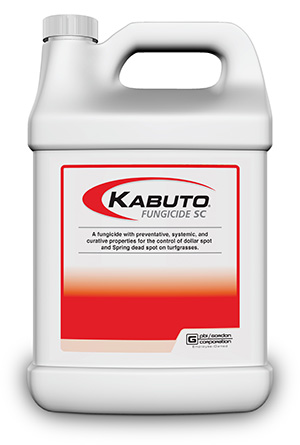
Kabuto Fungicide SC from PBI-Gordon features the active ingredient isofetamid, an SDHI fungicide and a top performer of sole active ingredient options. Photos courtesy of PBI-Gordon
Editor’s note: The following article was supplied by PBI-Gordon. All product claims, research cited and other information is directly from the company.
The dog days of summer are here, and most people are just focused on keeping cool. Out on the golf course, though, superintendents have more on their minds. They’re keeping that turf green and healthy, and working hard to keep golfers happy. Part
of that process: preparing for fall preventative applications to ensure protection against spring dead spot.
Any disease or weed control program begins with growing strong, healthy turf, and following best management practices. The pathogens that cause spring dead spot love poorly drained soil and over-irrigation. Regular aeration can reduce thatch buildup and
relieve soil compaction. It’s also vital to apply the appropriate fertilizer for your turf needs. Avoid excessive nitrogen applications, and do not apply nitrogen within six weeks of winter dormancy.
Ultimately, spring dead spot can and will impact even healthy turf, and in the United States, two pathogens cause it: O. korrae and O. herpotricha. Both are Ophiosphaerella species, so it would seem finding one active ingredient to deliver excellent control
of them both would be simple. No such luck. Fortunately Kabuto Fungicide SC from PBI-Gordon has you covered.

Kabuto features the active ingredient isofetamid, an SDHI fungicide and a top performer of sole active ingredient options, particularly when compared to single active treatments such as penthiopyrad and tebuconazole.
Some other fungicide active ingredients also don’t offer the flexibility that Kabuto does. Certain SDHI fungicides like pydiflumentofen, are only labeled for use on golf courses. Mefentrifluconazole, a DMI fungicide, can’t be applied to residential
turf. Kabuto is labeled for use on golf courses, commercial and residential turf, sports turf, and sod farms and has a flexible application schedule.
Application timing is important with any fungicide. For optimum spring dead spot control, Kabuto should be applied per label directions in the fall when soil temperatures at the 2-inch depth drop below 75°F for 3-5 consecutive days. A second application
may go down from 14- to 28-days (or later) after the initial application, but should be applied before soil temperatures fall below 60°F.
A two-application control strategy is preferred, but university studies have demonstrated that a single application of Kabuto at 3.2 fl. oz./1,000 sq. ft. provides near complete control of both spring dead spot pathogens. If you’re going with two
applications, apply Kabuto at split rates of 1.0-1.6 fl. oz./1,000 sq. ft.
Immediate post-application irrigation is also important to fungicide performance. Because spring dead spot pathogens reside in stolons, crowns, rhizomes, and the upper rootzone, at least 1/8” of irrigation immediately following application is vital.
A FRAC Group 7 fungicide, Kabuto also offers preventative and curative control of dollar spot, including control of certain carboxamide-resistant dollar spot populations. And, at 0.4 fl. oz./1,000 sq. ft., Kabuto can be applied up to eight times per year,
making it ideal as part of a resistance management program.
Thinking about spring dead spot during these long, hot days of summer seems nuts, but for golf course superintendents and other turf professionals, it makes complete sense. Fall fungicide applications are just around the corner. Be ready with the fungicide
proven to deliver excellent control of both spring dead spot-causing pathogens: Kabuto.